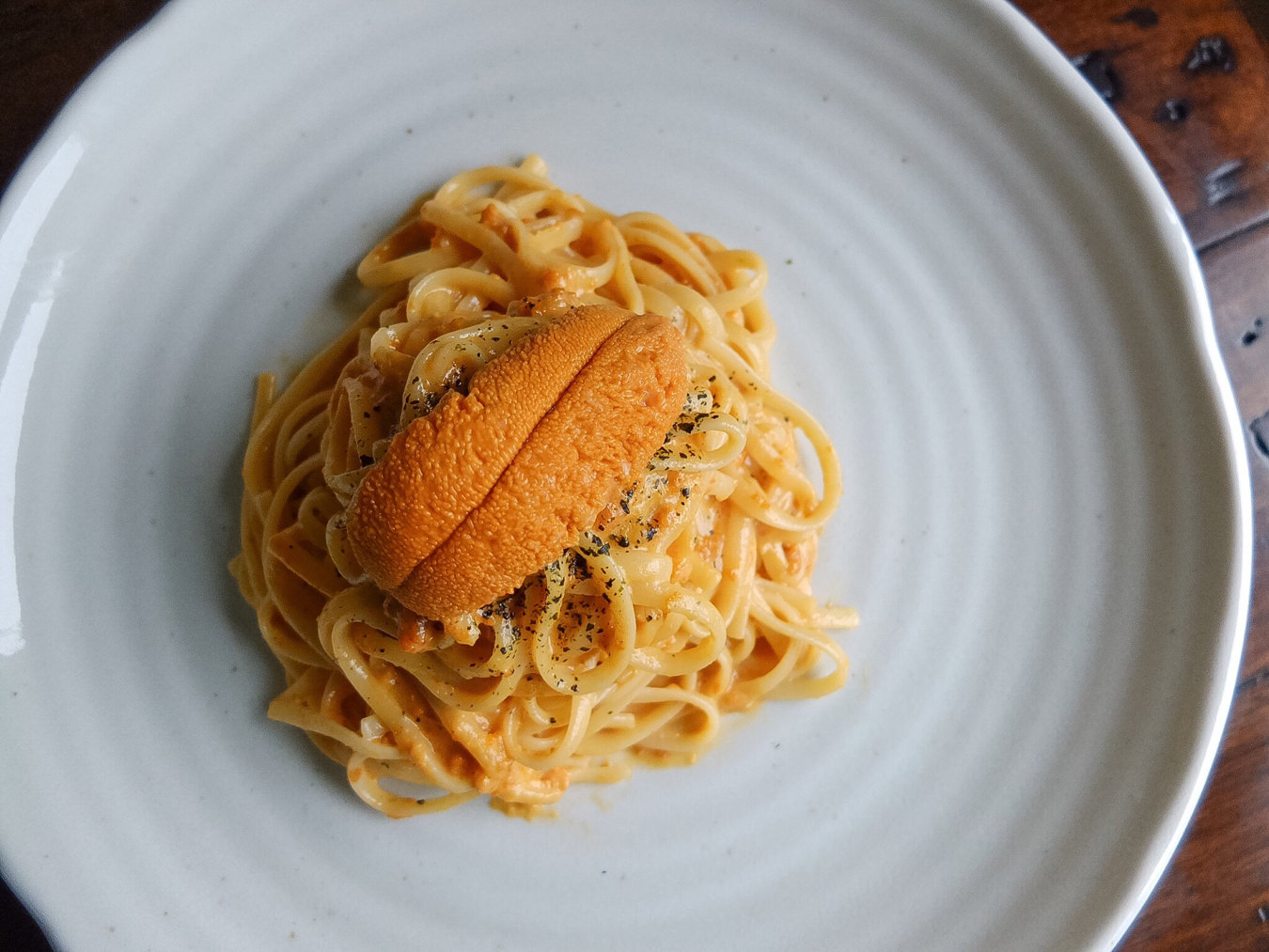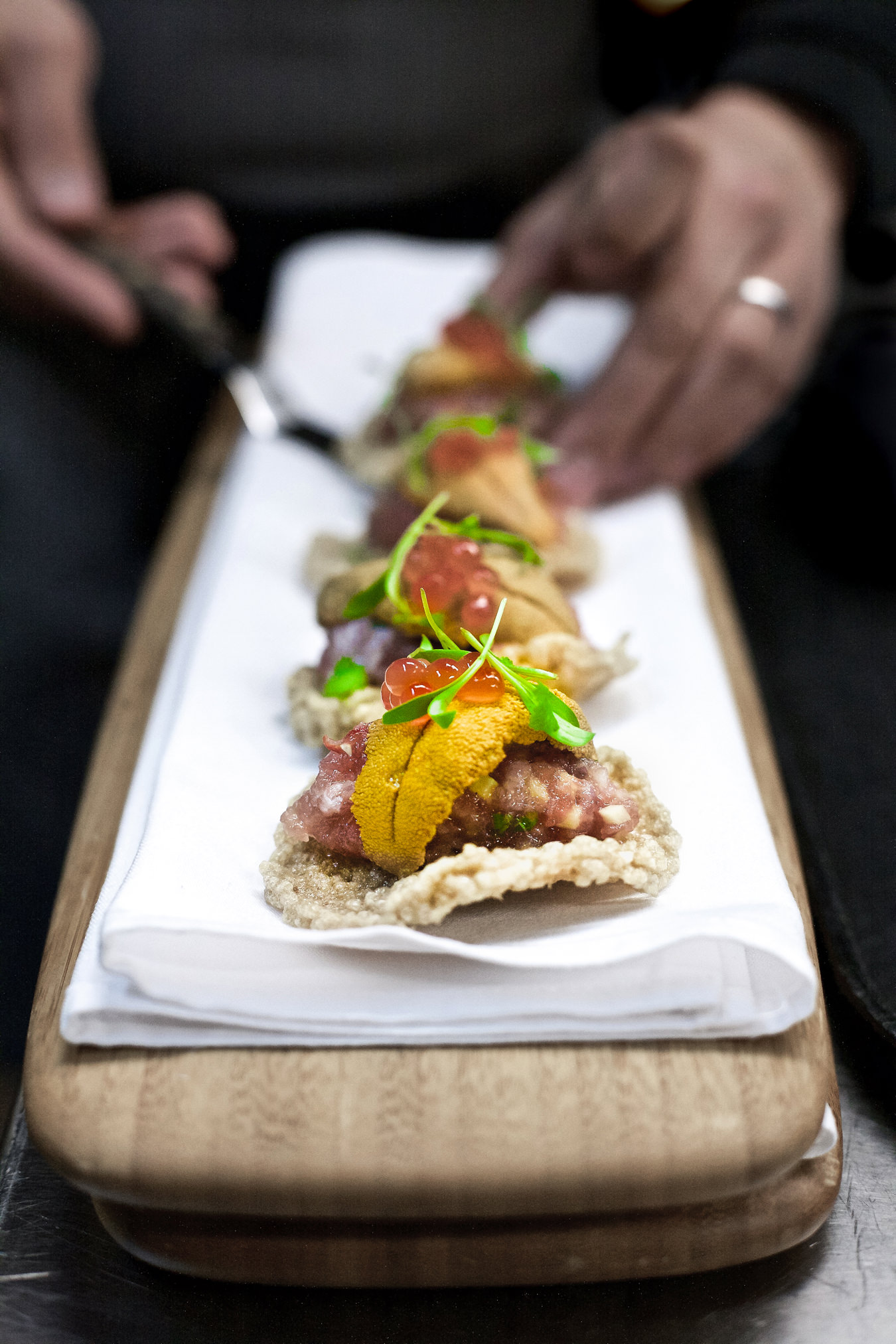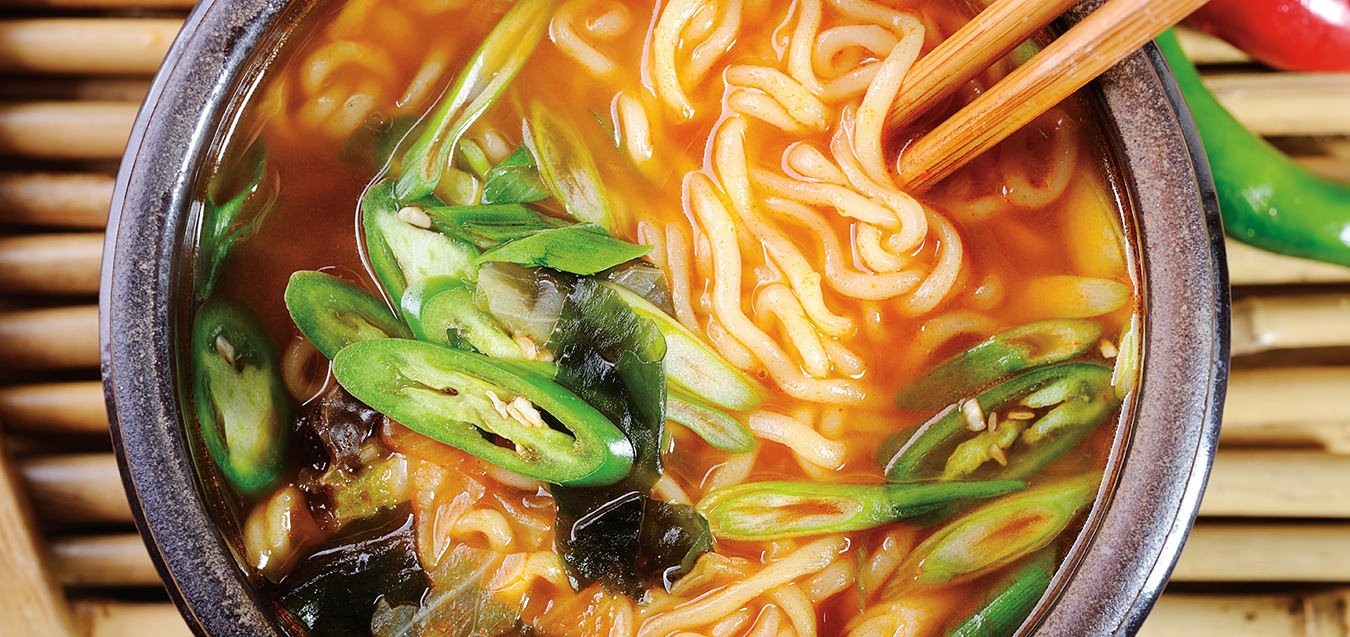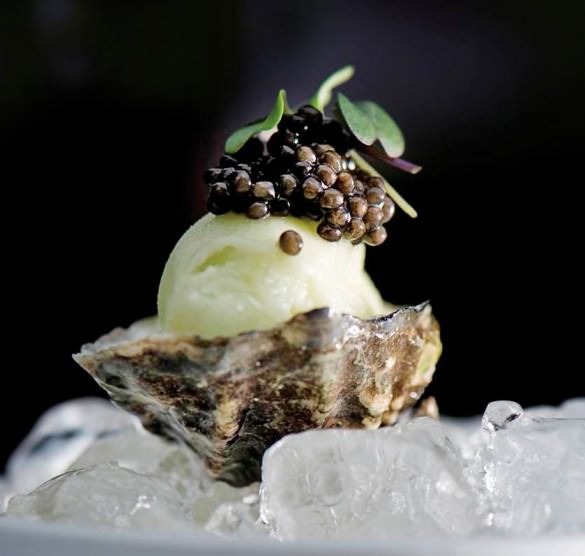-

Steamed turmeric curry custard with crab and uni as prepared by chef Angus An of Vancouver’s Maenam.
-

Sea urchin pasta with uni miso butter from Fresh Ideas Start Here (F.I.S.H.) sustainable seafood markets in Vancouver and Burnaby.
-

Sea urchin and ahi toro on a spot prawn cracker from Maenam. Photo by Leila Kwok.
Savouring Sea Urchin
Demystifying the shellfish.

The stillness of a misty February morning is broken by a splash as diver Tony Mulhall plunges into the frigid waters off British Columbia’s North Coast. Fighting bone-chilling temperatures, strong currents, and the all-too-real possibility of kelp entanglement, he swims down to the rocks below in search of Strongylocentrotus droebachiensis and Strongylocentrotus franciscanus—green and red sea urchin. Kuroshio captain David McRae keeps watch from the surface as waves buffet his boat and Mulhall hand-harvests the prickly echinoderms from ledges and crevices. It’s a risky endeavour, but a day’s work yields a bounty of treasure.

Steamed turmeric curry custard with crab and uni as prepared by chef Angus An of Vancouver’s Maenam.
A sea urchin’s spiny exterior belies the gastronomic delight that lies within. Crack one open and you’ll find five vibrant yellow-orange lobes. Commonly referred to as roe or coral, these are actually the animal’s reproductive organs and not the eggs themselves. Rich in minerals and nutrients, B.C.’s ocean environment is home to some of the world’s finest sea urchin. Called ricci di mare by Italians, kina by New Zealand’s Maori, oursin by the French, wana by Hawaiians, erizo by Chileans, uutuk by Alaska’s Alutiiq, and uni by the Japanese, it’s a highly prized delicacy in many cultures. Yet North American diners have been slow to embrace it.
Jenice Yu, owner of Fresh Ideas Start Here (F.I.S.H.) sustainable seafood markets in Vancouver and Burnaby, explains, “Sea urchin is definitely an acquired taste. Lots of people are hesitant to try it because they’ve had bad uni in the past. And good uni is hard to come by. You need to find a fishmonger who sells sea urchin at its freshest and also knows how to process it well.”
Rich in minerals and nutrients, B.C.’s ocean environment is home to some of the world’s finest sea urchin.
Freshness is definitely key. At its best from late September through March, sea urchin is buttery and creamy, but still slightly firm in texture. “Uni is sweet and delicate with a light brininess, like the best of the ocean without smelling or tasting fishy at all,” says Yu. “Red uni is more rich in texture and flavour, slightly more pungent and stronger tasting. Green uni is much smaller in size and a little sweeter.” Processing sea urchin is an exercise in timing. Fishing boats such as the Kuroshio, laden with mesh bags full of sea urchin, speed their daily catch straight to processing plant docks within hours of harvesting the shellfish.
Grand Hale Marine Products, owned by Yu’s family, has been processing sea urchin for over 30 years. Each one is cracked open by hand and the fragile uni gently scooped out for rinsing in a seawater solution. What follows is Grand Hale’s all-natural, proprietary process for curing the uni to preserve its texture and flavour. “Most places use alum during this step to firm up the texture, but alum produces a metallic taste that detracts from sea urchin’s natural sweetness. We don’t use alum at all, and thus are highly regarded by chefs.”
Once solely sought after by sushi bars and for export to Japan, these porcupines of the sea have begun to find widespread favour with Canadian gourmands. Montreal chef/restaurateur Antonio Park reflects, “Sea urchin is one of those things that’s very unique, very special. As Canada is so multicultural, immigrants have brought their love of it with them from their own countries. That has helped spread greater understanding of it as a delicacy.” Park has creatively featured sea urchin in his restaurants, from more traditional Japanese applications such as sashimi or chawanmushi, to deep frying it as tempura, curing and air drying it as bottarga, or delicately layering it in terrine.
“Uni is sweet and delicate with a light brininess, like the best of the ocean without smelling or tasting fishy at all,” says Yu.
In Vancouver, Maenam’s Angus An has witnessed the uptick in sea urchin’s popularity over the past 10 to 15 years, and the chef/restaurateur boldly incorporates it into his modern Thai menus. “Uni is now more revered as a premium product in the same way that foie gras first was,” he muses. “Even if people are hesitant about eating it, that cachet encourages them to try it for the first time.”
An has surprised and delighted diners with an uni “ice cream sundae” as part of the current seasonal chef’s tasting menu at Maenam. It’s accented with B.C. Dungeness crab, shoyu ikura (soy-cured salmon roe), young coconut, and spot prawn crackers. At Longtail Kitchen, his more casual outpost, An and chef de cuisine Justin Cheung incorporate smoked uni into fried rice as a special menu item available by preordering.

Sea urchin and ahi toro on a spot prawn cracker from Maenam. Photo by Leila Kwok.
If you’re apprehensive about eating uni, smoked sea urchin is the perfect introduction. It’s a specialty of Fresh Ideas Start Here and Grand Hale that’s brined and lightly cold-smoked with wood chips from fruit trees. Yu explains, “Cold smoking elevates the uni flavour, enhancing its natural sweetness without overpowering it.” And the process changes the sea urchin’s texture slightly, giving it an extra-decadent creaminess akin to that of a luxurious smoked cream cheese. Emulsified into pasta or risotto, the taste is sublime.
Yu is dedicated to educating people about the virtues of this underappreciated culinary delight. “Seeing that this is one of the few sustainable seafood items that’s in season during the winter months, we should all be indulging in nutrient-packed sea urchin.” Park echoes her ardour for uni saying, “It’s one of those things that you start eating and fall in love with slowly. And once you start falling in love, you can’t go back.”
_________
Never miss a story. Sign up for NUVO’s weekly newsletter.




